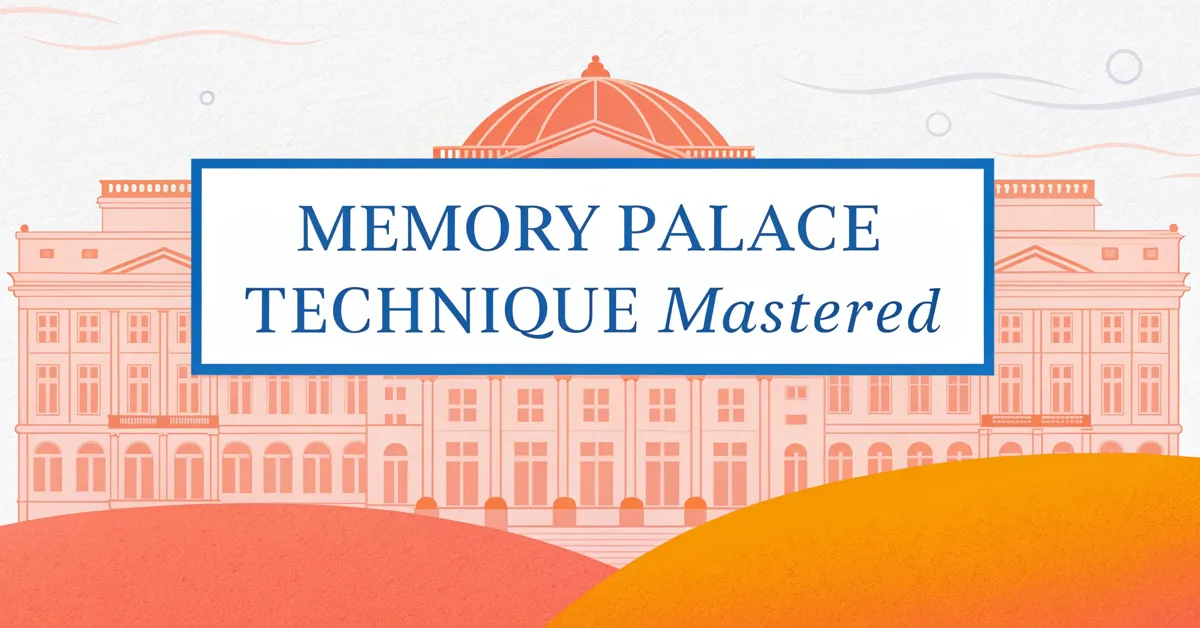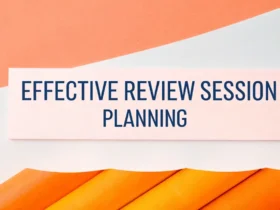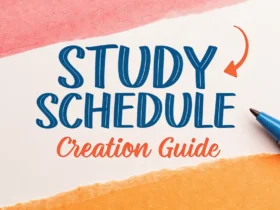Imagine a mental landscape, vast and varied, where every landmark represents a piece of information you need to remember. A towering oak might stand for the key events of the French Revolution, a babbling brook could represent the steps in a complex mathematical equation, and a cozy cottage might house the names of all the elements on the periodic table. Sounds like something out of a fantasy novel, right? But it’s a real, proven memory technique called the Memory Palace, and it’s ready to help you conquer complex information.
This isn’t just some parlor trick for memory champions. This memory technique has roots stretching back to ancient Greece. In those times, orators relied on it to deliver lengthy speeches without notes. Now, students worldwide, no matter their degree, find it indispensable for learning. And you’re about to discover why.
In this article, you’ll learn how to build your own Memory Palace, step-by-step. You’ll learn how to use it to remember anything from historical timelines to scientific formulas. Get ready to unlock your memory and master complex information.
What is the Memory Palace Technique?
The Memory Palace, also called the method of loci, is an ancient memory technique that relies on spatial relationships to recall information. “Loci” is Latin for “places.” By associating facts with specific locations in a familiar place, you can create a mental map that guides your memory retrieval.
Imagine your home. Visualize each room, each piece of furniture, and each detail. Now, picture yourself placing the information you want to remember at specific spots within your house. As you mentally walk through your home, you encounter these spots and easily recall the associated information.
This memory technique works because our brains are naturally good at remembering places. Think about how easily you can navigate your neighborhood or recall the layout of your childhood home. The Memory Palace taps into this innate ability.
Why Does the Memory Palace Technique Work?
The Memory Palace works due to several key principles of how our brains process and store information. Let’s look at the science.
Spatial Memory
Our brains have a remarkable capacity for spatial memory. The hippocampus, a region in the brain, plays a crucial role in spatial learning and navigation. Studies using brain scans show that the hippocampus activates when we recall places and navigate mentally.
Think of taxi drivers in London. They must learn “The Knowledge,” the intricate layout of the city’s streets. Research has shown that London cabbies have larger hippocampi than the average person, directly correlated with the time they’ve spent navigating the city. This suggests that spatial memory is strengthened through practice and experience.
The Memory Palace exploits our natural spatial memory abilities. By associating information with specific locations, we leverage this innate capacity to create a more robust memory technique.
Visualization
Visualization enhances memory by engaging multiple areas of the brain. When we visualize something, we’re not just using our visual cortex. We also activate regions associated with emotions, senses, and motor skills. This multi-sensory engagement creates richer, more memorable mental images.
A study in the journal Neuropsychologia showed that participants who used visual imagery to learn new information had better recall than those who relied on rote memorization. Visualization creates a more vivid and engaging memory technique.
The Memory Palace relies heavily on visualization. By creating detailed mental images of the locations and the information you’re placing there, you make the memories stronger and easier to recall.
Association
Association is a fundamental principle of memory. Our brains naturally form connections between different pieces of information. By linking new information with existing knowledge, we create a web of associations that makes recall easier.
The American Journal of Psychology published research highlighting the importance of association in memory technique. The study found that when people actively create associations between new and old information, they remember the new information better.
The Memory Palace capitalizes on association by linking the information you want to remember with specific locations in your mental landscape. The more vivid and unusual the association, the more likely you are to remember it.
Elaboration
Elaboration involves adding detail and context to the information you’re trying to remember. This can include creating stories, generating vivid images, or connecting the information to your personal experiences.
Research in Memory & Cognition demonstrates that elaboration enhances memory encoding. When we elaborate on information, we process it more deeply, creating more durable memories.
The Memory Palace encourages elaboration by having you create detailed and engaging mental images. You’re more likely to remember something if you can create a bizarre or funny story involving that information at a particular location.
How to Build Your Memory Palace
Ready to build your own Memory Palace? Here’s a step-by-step guide to get you started.
Choose a Familiar Location
The first step is to select a location that you know well. This could be your home, your school, your workplace, or any other place you can easily visualize. The more familiar the location, the easier it will be to navigate in your mind.
Walk through the location in your mind. Pay attention to the details, the colors, the textures, and the layout. The more vivid your mental image, the better.
Identify Distinct Landmarks
Once you’ve chosen your location, identify a series of distinct landmarks within it. These landmarks will serve as the “loci” or places where you’ll store the information you want to remember.
A landmark must be memorable and easily distinguishable from other landmarks. Think of things like:
- Specific pieces of furniture (e.g., the kitchen table, the living room couch)
- Architectural features (e.g., the front door, the staircase)
- Decorations (e.g., a painting, a plant)
Plan your route through the Memory Palace. This route must be logical and easy to follow, ensuring that you visit each landmark in a consistent order. Start at the front door, move through the living room, then the kitchen, and so on.
Associate Information with Landmarks
With your landmarks in place, it’s time to start associating them with the information you want to remember. This involves creating vivid, memorable mental images that link each piece of information with a specific landmark.
Make the images as bizarre, funny, or unusual as possible. The more outlandish the image, the more likely you are to remember it.
If you’re trying to remember the steps of a scientific process, picture each step taking place at a specific landmark. Place beakers bubbling at the kitchen table, or a microscope examining samples on the living room couch.
Rehearse Your Memory Palace
After associating the information with your landmarks, take time to rehearse your Memory Palace. This involves mentally walking through your location, visiting each landmark, and recalling the associated information.
Repeat this process several times to reinforce the connections between the landmarks and the information. The more you rehearse, the stronger the memories will become.
Review your Memory Palace regularly. This will help you maintain the memories over time and prevent them from fading.
Tips for Using the Memory Palace Effectively
Here are some tips to help you get the most out of the Memory Palace technique.
Be Specific
The more specific you are with your landmarks and mental images, the better. The more distinct and memorable the images, the easier it will be to recall the associated information.
Use vivid details, colors, and sensory experiences to make the images stand out.
Be Creative
Don’t be afraid to get creative with your mental images. The more bizarre, funny, or unusual the image, the more likely you are to remember it.
Think outside the box and let your imagination run wild. Create scenarios and stories that will stick in your mind.
Be Consistent
Consistency is key when using the Memory Palace. Use the same landmarks and routes each time you practice. This will help reinforce the connections between the landmarks and the information.
Stick to the same Memory Palace for a specific topic. This will help you organize and categorize your memories more effectively.
Start Small
Don’t try to memorize too much information at once. Start with a small set of facts and gradually add more as you become more comfortable with the technique.
Break down complex information into smaller, more manageable chunks. This will make it easier to associate with specific landmarks.
Practice Regularly
Like any skill, the Memory Palace requires practice. The more you use it, the better you will become at creating and recalling mental images.
Set aside time each day to practice your Memory Palace. Review the information you have stored there and add new information as needed.
Examples of Memory Palace in Action
Here are some real-world examples of how you can use the Memory Palace to remember complex information.
Historical Timelines
Imagine you need to remember the key events of World War II. You could create a Memory Palace based on your home and associate each event with a specific landmark.
- Front Door: Picture the invasion of Poland. Soldiers marching through your front door.
- Living Room: Think of the attack on Pearl Harbor. Planes crashing into the living room.
- Kitchen: Think of the Battle of Stalingrad. Soldiers fighting in the kitchen.
- Bedroom: Picture D-Day. Soldiers storming the bedroom.
- Backyard: Visualize the bombing of Hiroshima. A mushroom cloud rising in your backyard.
By mentally walking through your house, you can recall the key events of World War II in chronological order.
Scientific Formulas
Let’s say you need to memorize the formula for photosynthesis: 6CO2 + 6H2O + Light Energy → C6H12O6 + 6O2.
- Front Door: Six carbon dioxide molecules (6CO2) forming a pattern on your front door.
- Living Room: Six water molecules (6H2O) spilling on the living room carpet.
- Kitchen: Light energy shining from the kitchen.
- Bedroom: One glucose molecule (C6H12O6) resting on the bed.
- Backyard: Six oxygen molecules (6O2) floating in the backyard.
By mentally walking through your house, you can recall the formula for photosynthesis.
Foreign Language Vocabulary
If you’re learning a new language, you can use the Memory Palace to memorize vocabulary words. Associate each word with a specific landmark.
- Front Door: The Spanish word for “door” (puerta) painted on your front door.
- Living Room: The French word for “couch” (canapé) resting on the living room couch.
- Kitchen: The German word for “table” (Tisch) placed on the kitchen table.
- Bedroom: The Italian word for “bed” (letto) resting on the bed.
- Backyard: The Japanese word for “tree” (ki) growing in the backyard.
Walking through your house, you can recall the foreign language vocabulary words.
Is the Memory Palace the Right Memory Technique for You?
The Memory Palace is a powerful memory technique, but it’s not for everyone. Here are some factors to consider when deciding if it’s right for you.
Learning Style
If you’re a visual learner, the Memory Palace may be a great fit. The technique relies heavily on visualization.
If you prefer other learning styles, such as auditory or kinesthetic, you may find the Memory Palace less effective. You might need to adapt the technique to suit your preferences.
Complexity of Information
The Memory Palace is useful for memorizing complex information. If you’re trying to remember simple facts, other memory technique might be more efficient.
For large amounts of complex information, the Memory Palace may require significant time and effort to set up and maintain.
Time Commitment
Creating and rehearsing a Memory Palace takes time and effort. If you’re short on time, you may find it difficult to commit to the technique.
Regular practice is essential for maintaining the memories stored in your Memory Palace. If you don’t practice, the memories may fade over time.
Spatial Reasoning
The Memory Palace relies on spatial reasoning skills. If you have difficulty visualizing locations and routes, you may find the technique challenging.
Practice your spatial reasoning skills by playing games, solving puzzles, or simply exploring new places.
Supercharge Your Studies: The Memory Palace Awaits
So, is the Memory Palace a complex gimmick or the memory technique you’ve been looking for? Science points to the latter. By tapping into your brain’s innate ability to remember places, this ancient method turns abstract information into a vivid, navigable landscape.
It takes effort and practice to master, but the benefits are immense: improved recall, better comprehension, and the ability to learn complex information with ease. Take that first step, choose your location, identify your landmarks, and start building your own Memory Palace. Your academic success awaits!















Leave a Reply
View Comments